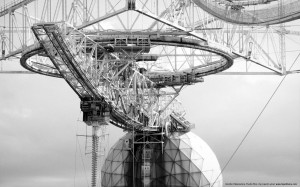An amazing view of the superstructure of the 305-meter radio telescope located near the town of Arecibo, Puerto Rico. This telescope caught my eye for a couple of reasons. First, well, just look at that engineering. Suspension cables, truss work, the lattice work on the Gregorian dome…the construction photos make for fantastic viewing
The image above shows five major components of the telescope’s superstructure:
1) We’re looking at the underside of a triangular “platform” that weighs some 900 tons. The platform is suspended on 18 steel cables. Six more cables connect the corners (two at each corner) to jacks used to adjust height of platform (millimeter by millimeter).
2) The circular structure on the underside of the triangular platform is the track on which the 328-foot azimuth arm rotates.
3) The azimuth arm (the bowed trusswork) is another track system. The carriage house travels on one end of the track, the Gregorian dome travels on the opposite end.
4) The carriage house serves as the terminus for various linear antennae tuned to a narrow band of frequencies. The antennae are directed downward, toward a massive reflector dish.
5) The Gregorian dome is a complicated beast but it essentially enables the spherical reflector of the telescope to behave as if it was a parabolic reflector (the most common shape used for radio telescopes). That odd hanging half-dome contains a multi-beam receiver that can look at seven reflected beams at simultaneously (as opposed to a single-signal linear antenna).
The second reason that observatory caught my eye is that it was designed to take advantage of the geological formations of the site. That huge dish is built on a natural karst (again, the construction photos tell a good story). It’s good to know karst land is good for something other than swallowing holes, collapsing mines, and breaking legs.
In recent years, the telescope has been scrambling for funding, but the NSF has decided to fund it through at least 2016. That gives me five years to figure out a way to go see this place in person.
